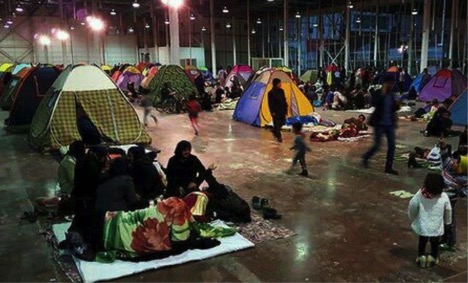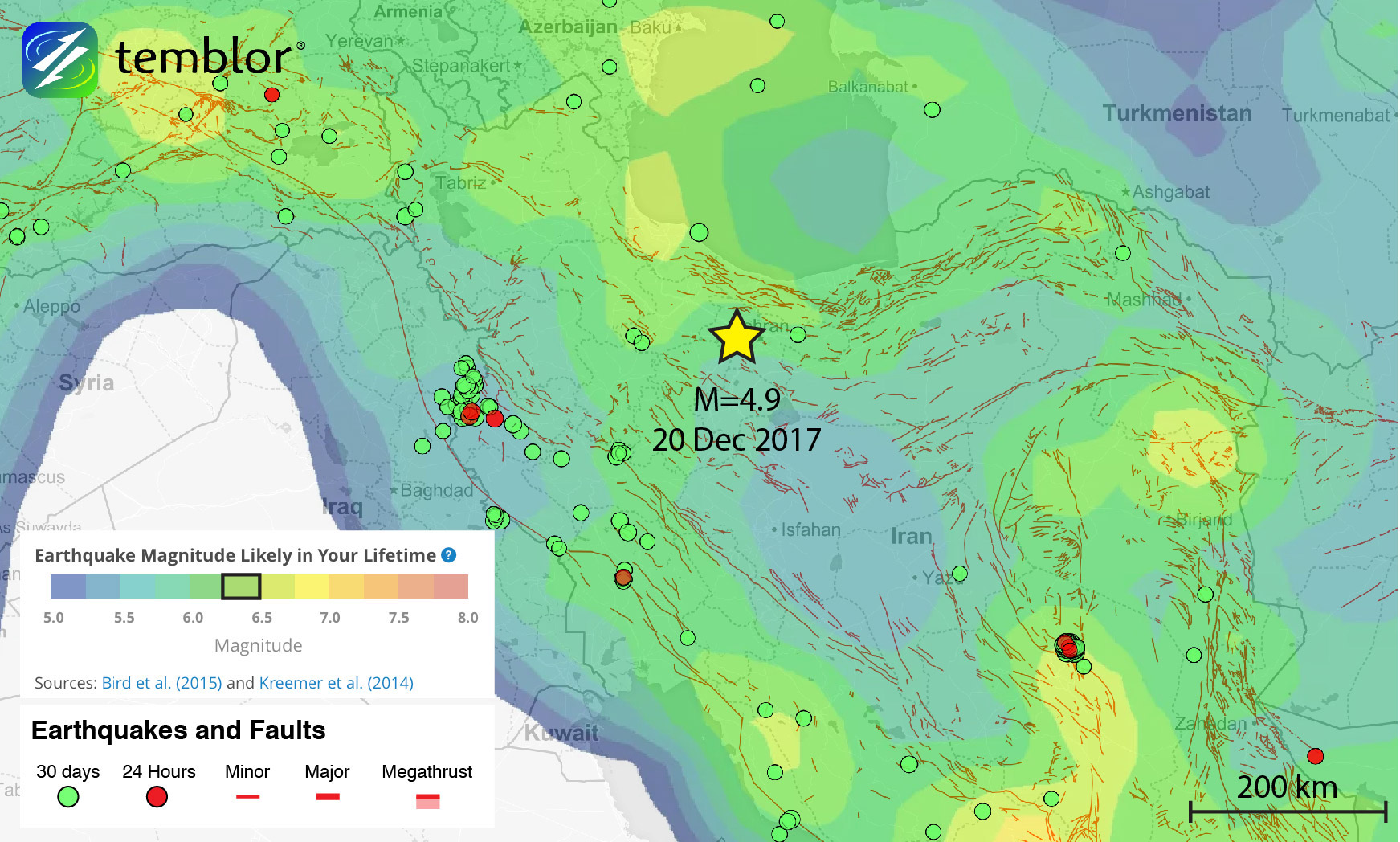By Manuel Berberian, Ph.D. (University of Cambridge, UK); Elected Member, New York Academy of Sciences
Click here to read the response from the Director of the Iranian Seismological Center
Click here to read the post in Persian

A M=4.9 earthquake shakes Tehran
Last night, just before 11:30 p.m. local time, a M=4.9 earthquake struck just west of Iran’s capital city of Tehran (home to 15 million people), in the Malard region. The epicenter of this quake occurred just east of a M~5.7 in 1876, and northeast of a M=7.0 in 1967, illustrating that the area is susceptible to large earthquakes (fig 12.13 in Berberian, 2014; fig. 9 in Berberian and Yeats, 2016). Recent seismicity in the area around the epicenter of last night’s earthquake began on November 18th with a M=2.3 quake. This was followed by nine more earthquakes ranging in magnitude from 1.9-3.2 over the next month.

People in and around Tehran rushed outside during the earthquake, and about 117 people were injured. Unfortunately, two people died due to heart attack and shock. In terms of structural damage, some houses were cracked, with no further damage being being reported by state media (irna.ir; isna.ir; Kayhan; Ettela’at, etc.). Additionally, the earthquake triggered rockfalls at three points along the Karaj-Chalus (Tehran-Caspian Sea) highway and reportedly damaged a car resulting in traffic police instructing people to not using the highway. Telecommunication was also interrupted in the Tehran and Karaj provinces.

Good Advice and Bad
The head of Iran’s Seismology Institute, Ali Moradi, stated that the risk of a major earthquake in the capital city of Tehran has decreased, as several weak aftershocks were registered following a magnitude 5.2 tremor, which affected six Iranian provinces. Ali Moradi said seven 2-3 magnitude aftershocks have been registered in Tehran so far, adding, “There is no more concern for larger tremors”, IRNA reported on Thursday (Link). Of course, nothing could be farther from the truth. Worldwide, there is about a 2-10% chance that a M≥5 earthquake will prove to be a foreshock of a lager event. The USGS issues seismic advisories after all moderate and larger earthquakes in the U.S. on the basis of these statistics. The occurrence of aftershocks of the M=4.9 earthquake in no way invalidates this likelihood. [Editor’s Note: We have been contacted by Dr. Moradi, Director of Iranian Seismological Center at Institute of Geophysics, University of Tehran, to say that he was misquoted by press. As soon as he sends his views, we will post them in lieu of the IRNA report.]
In contrast, the head of Tehran’s Crisis Management Organization, Ahmad Sadeghi, had earlier told reporters that “the earthquake can have more aftershocks. The aftershocks can even be more powerful. The Crisis Management Organization calls on people to stay vigilant and move to nearby safe places.” This statement is correct, and the advice he is offering is sound.
Following the earthquake, the governor general of the Tehran province ordered that all government offices be closed on Thursday December 21, and instructed that people remain calm, only follow the state news media, and not to visit foreign news media sites. He also cancelled the vacations of security, police, and government personnel. Mohammad Najjar, Director of the State-run National Disaster Management Organization of Ministry of Interior in Tehran stated that the people should stay in safe areas. This statement was followed by Dr. Ali Baitollahi from the National Earthquake Group saying that the people of Tehran and Karaj should stay three hours in safe places like parks or inside their cars. These authorities did not explain how 15 million people in the greater Tehran and Karaj area can find safe and secure facilities. Dr. Fatemi Aghda, a seismology professor, announced that the Wednesday earthquake just before midnight was the mainshock and not a foreshock of a larger earthquake, that the earthquake was predictable, and rejected the notion of the possibility of a destructive earthquake in Tehran (irna.ir, 2017.12.21).
Looking Forward
It should be reiterated that earthquakes in the Tehran-Karaj-Qazvin areas of the southern foothills of the mighty Alborz mountains, are foreseeable and inescapable (Berberian and Yeats, 2016). Instead of false and unrealistic statements, the authorities should prepare the citizens for the occurrence of large-magnitude earthquakes. They should seriously retrofit the vital structures, replace poorly constructed buildings, stop the corruption in the building industry, and enforce the “Iranian Code for Seismic-Resistant Buildings Design” (IRISI Code No. 519, 1969; later revised as No. 2800 in February 1988 and 1999) throughout the country. Despite the implementation of the Iranian seismic-resistant building design code about half a century ago, in the last 40 years, about 101,000 Iranians lost their lives during the 1979-2017 earthquakes. It is because of building construction and quality that a person in Iran is 1,000 times more vulnerable to an earthquake than someone in California. The figure below from Jaiswal and Wald 2010 highlights fatality rates in countries around the world.


References cited
Berberian, M., 2014. Earthquakes and Coseismic Surface Faulting on the Iranian Plateau; A Historical, Social, and Physical Approach. Elsevier, Developments in Earth Surface Processes, 17, 776p., ISBN: 978-0-444-63292-0.
Berberian, M., and Yeats, R.S., 2016. Tehran: An Earthquake Time Bomb. In: Tectonic Evolution, Collision, and Seismicity of Southwest Asia: In Honor of Manuel Berberian’s Forty-Five Years of Research Contributions. Geological Society of America Special Paper 525, DOI: 10.1130/2016.2525(04).
Kishor Jaiswal and David Wald (2010), An Empirical Model for Global Earthquake Fatality Estimation, Earthquake Spectra, 26, 1017–1037, DOI: 10.1193/1.3480331
- Beware quiet segments of the Philippine Fault - May 16, 2025
-
ډیری عوامل افغاني ټولنې د زلزلې پر وړاندې زیانمنوي
- August 11, 2022 - What’s happening this week in Humboldt County, California: The squeeze - February 6, 2019
